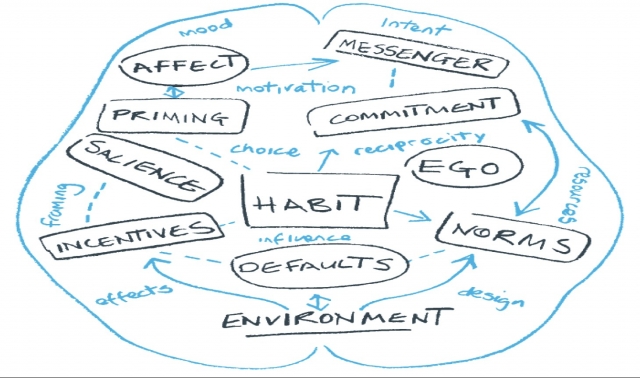Mindspace: a New Way of Influencing Behavior through Public Policy
By Givi Kupatadze
The ISET Economist, a blog about economics in Georgia and the South Caucasus by the International School of Economics at TSU (ISET)
WHY GOVERNMENT NEEDS TO UNDERSTAND MINDSPACE?
Influencing behavior is central to public policy. Policy-makers have many tools to change or shape behavior. Legislation and regulation are traditional tools used to achieve public policy goals. While these tools are often very effective they are not always advantageous. Effective law enforcement is expensive business for government. During last 3 decades behavioral science has significantly advanced understanding the influences on behavior. Main advantages of behavioral approach over traditional tools are low cost, increased effectiveness and non-coerciveness, and government needs to consider them.
HOW MINDSPACE CAME INTO EXISTENCE?
The Cabinet Office of UK commissioned the Institute for Government to prepare the report about implications of behavioral science for policy-making. MINDSPACE has been developed as an attempt to design framework for incorporating behavioral insights into policy-making. David Cameron established under his cabinet Behavioral Insights Team known as the “Nudge Unit” in 2010. Using insights of behavioral science, the Nudge Unit managed to reduce fraud, to increase savings and recruitment level among minority groups, and to improve effectiveness in many other domains of public policy. The White House launched its own Nudge Unit team under Barack Obama’s administration in 2013. Government of Australia followed a path of the USA and UK and introduced the Nudge Unit inside the Department of Prime Minister & Cabinet in 2015. Taking into account the success stories of these countries in applying behavioral insights into policy-making it’s reasonable to assume that many other countries will jump on the train of non-coercive policy-making.
WHAT IS MINDSPACE?
MINDSPACE is a tool for changing behavior. Most important nine non-coercive and robust influences on human behavior are captured in a simple mnemonic of MINDSPACE and can be used as a checklist when making policy.
|
Messenger |
We are heavily influenced by who communicates information. |
|
Incentives |
Our responses to incentives are shaped by predictable mental shortcuts such as strongly avoiding losses. |
|
Norms |
We are strongly influenced by what others do. |
|
Defaults |
We ‘go with the flow’ of pre-set options. |
|
Salience |
Our attention is drawn to what is novel and seems relevant to us. |
|
Priming |
Our acts are often influenced by sub-conscious cues. |
|
Affect |
Our emotional associations can powerfully shape our actions. |
|
Commitments |
We seek to be consistent with our public promises and reciprocate acts. |
|
Ego |
We act in ways that make us feel better about ourselves. |
WHICH POLICY CHALLENGES CAN BE TACKLED BY MINDSPACE?
Domain of public policy where MINDSPACE can be applied is wide. Some of public policy areas where MINDSPACE has been used successfully and can be relevant for policy challenges facing by the Government of Georgia are: crime and anti-social behavior; healthy lifestyle; and pro-social behavior, like volunteering and voting. Case studies revealed possibilities for non-coercive and low cost interventions, for example:
- Logic of gang members can be used to combat gang violence (Norms).
- Giant bananas can be used to reduce littering (Salience).
- Inertia can be useful to save more for retirement (Defaults).
Other ideas for action can be:
- Combating obesity in schools – using principles of choice architecture to improve diet in schools’ cafeterias.
- Helping people to help themselves – using self-exclusion agreements to restrict access to online casinos and betting sites.
It must be noted that a list of possible public policy domain where MINDSPACE can be applied is virtually unlimited.
HOW MINDSPACE CAN BE APPLIED INTO POLICY-MAKING?
The 6 Es: Explore, Enable, Encourage, Engage, Exemplify and Evaluate represent a framework within which MINDSPACE can be applied. Bringing the 6 Es together allows policy-makers to address the over-aching “so what?” question in practical ways.

CONCLUSION
Policy-makers need to understand and react accordingly to the fact that all the time we are being influenced and at the same time influencing others. Most of us are creatures of habit and environment where we live in. Key point is that government forms significant part of this environment, whether intentionally or not. Government will always be facing choices to make: to introduce pension scheme as opt-in or opt-out; deciding who will be communicating the message; and so on. Applying MINDSPACE into public policy can help to turn preciously invisible influences into explicit choices and policy-makers into good “choice architects”.
____________________________________________________________________________________
Givi Kupatadze is a PhD candidate at Estonian Business School. His primary research interests are economic development and implications of behavioral economics for public policy. He is visiting lecturer at Ilia State University and has successful working experience at international organizations.












